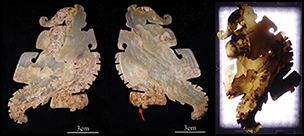Crossref Citations
This article has been cited by the following publications. This list is generated based on data provided by
Crossref.
2018.
ANNUAL BIBLIOGRAPHY.
Early China,
Vol. 41,
Issue. ,
p.
477.
Su, Xin
Tang, Xiaojia
Zou, Qiushi
and
Zhang, Changping
2021.
Stones from the Bronze Age: Raw materials and exploration of the stone artifacts from Panlongcheng.
Journal of Archaeological Science: Reports,
Vol. 40,
Issue. ,
p.
103259.
Wang, Rong
Mai, Yunyi
and
Lin, Liugen
2022.
Burnt jade sacrifices in the Chinese Neolithic: the Liangzhu cemetery at Sidun.
Antiquity,
Vol. 96,
Issue. 390,
p.
1495.
Guo, Yuming
Xiang, Fang
Ran, Honglin
Xie, Zhenbin
Yang, Qi
Huang, Hengxu
and
Ding, Li
2023.
The sacrificial record in burial pits of the late Shang Dynasty: evidences from the chroma and magnetic properties of the Sanxingdui site, Sichuan, China.
Heritage Science,
Vol. 11,
Issue. 1,
Lu, Hao
Fu, Wanlu
Xu, Shiyu
Chai, Jun
Ran, Honglin
Lei, Yu
and
Zhao, Hao
2023.
Characterizing ancient jade by on-site analysis in Sanxingdui, China.
Heritage Science,
Vol. 11,
Issue. 1,
Zhang, Kexin
Zhang, Yaxu
Zhao, Jing
Zhao, Zhanrui
Zhao, Meng
Zhao, Xichen
and
Luo, Hongjie
2023.
Corrosion analysis of unearthed jade from Daye Zhen Tomb of Northern Zhou Dynasty.
Heritage Science,
Vol. 11,
Issue. 1,
Wang, Rong
and
Li, Yifan
2024.
Encyclopedia of Archaeology (Second Edition).
p.
454.
Xu, Chujing
Liu, Jiancheng
Wang, Yunpeng
Ran, Honglin
Wu, Haoze
Fang, Hui
and
Ma, Qinglin
2025.
The deterioration structure of tremolite jade artifacts from the Sanxingdui sacrificial pits dated to the Shang Dynasty in Guanghan, Sichuan, China.
npj Heritage Science,
Vol. 13,
Issue. 1,
